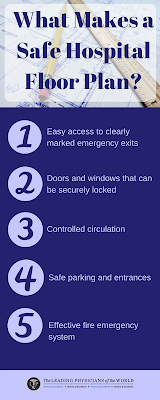Hospital Building Designs and Plans
The United
States is currently in the midst of an unprecedented health care building boom,
with a projected $180 billion investment in new hospital construction expected
in the next five years. A similar trend is being observed internationally. The
key drivers for this boom in the United States include aging facilities (built
in the 1950s and 1960s) that no longer support efficient and safe care
delivery; advances in treating childhood diseases; rapidly emerging
technologies that fundamentally change care delivery processes; and the growing
importance of patient- and family-centered care. Most importantly, the
heightened focus on improving patient, environmental, and workforce safety and
quality has increased the need to create optimal physical environments.
A growing
body of research shows that there is a strong link between the design of health
care settings and outcomes experienced by patients, staff, and families. There
is mounting recognition that risks and hazards of health care–associated injury
and harm are a result of problems with the design of systems of care rather
than poor performance by providers. Furthermore, there is substantial evidence
that the design of hospital physical environments contributes to medical
errors, increased rates of infection and injuries from falls, staff injury,
slow patient recovery, and high nurse turnover. The wider costs of lost working
time, disability, and economic consequences are greater still.
Well-designed,
supportive health care environments can not only prevent harm and injury but
also provide psychological support and aid the healing process. It has now
become imperative to rethink facility design as a critical element in bringing
about change in the way health care is provided and experienced in health care
settings.
This approach reflects a significant change in the way design
practitioners, health care planners, and health care administrators undertake
health care facility design. By linking health care building design strategies
with key desired outcomes such as reduced health care–associated infections,
reduced falls, increased energy savings, increased patient satisfaction, and
increased market share, the discussion at the design table is no longer about
the first costs of health care facility design or about meeting immediate
facility space needs but about the role of the physical environment in
supporting the mission of the organization in providing high quality care. This
is a positive trend that will affect the quality of health care facilities
being built in the years to come.
In today’s
reimbursement climate, where hospitals will increasingly be compensated for
performance, it has become evident that the business-case discussion must be
about the potential long-term savings from cost avoidance due to a reduction in
avoidable adverse events that represent huge costs to both the health care
organization and the patients and families who receive care. By linking the
design of the physical environment with an organization’s patient safety andquality improvement agenda, processes such as evidence-based design are
providing a common language of communication for architects, clinicians, and
facility administrators.




Comments
Post a Comment